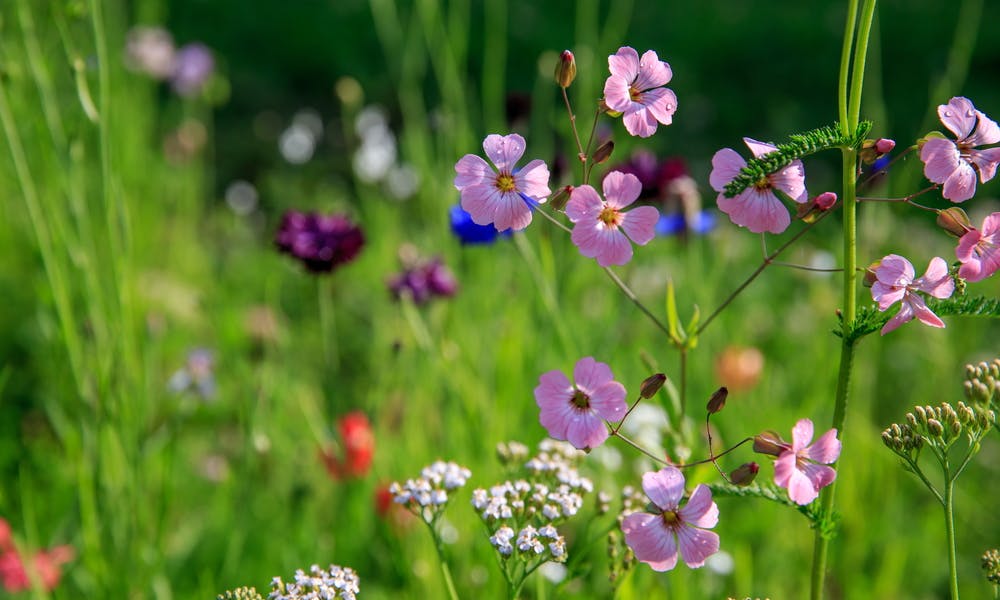MENU
Wildflowers Around the World

Whether they are gracing the inside of our homes, workspaces, or being grown in our gardens, the many flowering species that exist throughout the world hold a special place in the hearts and minds of humans. With so many varieties being cultivated every year, we sometimes forget that these gorgeous plants are just as wild as the animals we all love. Walking alongside streams, rivers, in deep forests or on hillsides, wildflowers can be found wherever your feet take you. There is no country, no place on earth that is free of flowering plants. We are going to explore the history of flowers and all the magical properties that they bring to our lives.
Keep on reading to find out the:
- Facts on the First Wildflowers
- Common Characteristics
- North American Wildflowers
- Central and South American Wildflowers
- African Wildflowers
- European Wildflowers
- Some Interesting Medicinal Qualities
Facts on the First Wildflowers
Wildflowers, as you can assume from their name, are flowers that grow in the wild, which is to say that they were not planted in an area by human hands. Ideally referred to as native species, these flowers have been around for as long as homo sapiens, with fossil records showing evidence of them as far back as 100 million years ago. Unlike introduced species, which tend to be invasive, native flower species generally co-exist with other plants and animals in a beautiful symbiosis, benefitting the surrounding nature they live in. As far as we know, flowers only began to be cultivated when the Greek botanist Theophrastus, in 300 B.C, studied and named more than 500 of the plants. This allowed the Romans, around 23 B.C., to begin experimenting with cultivating different breeds.
Common Characteristics
Most wildflowers, as well as cultivated flowers, hold many of the same characteristics. The main biological purpose of a flowering plant is to reproduce. Many flowers do this through the usual way, creating a mechanism so that they can fertilize a female cell with a male cell. They may sometimes go outside their native species to facilitate this, or simply self-fertilize, with many hermaphrodite species existing. Most of these flowers have created a system to attract insects, and animals such as birds, to aid in the spread of their pollen for germination. After being fertilized, most of the plants produce fruits containing seeds, bulbs, or bulb-like tubers called corms. All these aid in propagating the species.
North American Wildflowers
With so many species having been introduced into the Americas by conquerors and explorers, finding out whether species are native can be troublesome. Some of the more common include viburnum trilobum, which produces bright red berries, giving rise to dark, red foliage in the fall. The lobelia is another gorgeous plant native to North America, it blooms with wonderful purple-blue petals that are quite stunning. White sage, very important in Native American culture, is used in their traditional medicines. The gaillardia, known in popular culture as the blanket flower, covers fields in a layer of gorgeous red, yellow, and orange petals that are beautiful to behold.
Central and South American Wildflowers
The erythrina crista-galli, besides having an incredibly cool name, is a native species found in South America. It has deep, cone-shaped petals with a protuberance in the center that led to it receiving the nickname cockspur coral tree. The orchid, one of the most prolific of flowering plants, is a native as well, its beautiful flowers gracing many countries. Native to the Andes mountains, the sacred flower of the Incas, another flower with a wonderful name, is a flashy red flower that resembles a miniature trumpet in shape.
African Wildflowers
Continuing with some of the different continent’s native species, we find some fascinating flowers within Africa. The amaryllis belladonna, found in South Africa, is a gorgeous lilac-colored flower that is quite famous as a hardy plant that grows well indoors. The flame lily, a vividly red flower resembling the mouth of a predator, is one of the more dangerous flowers in existence, with every part of it being highly toxic to humans and animals alike. Another beautiful native is the African Daisy, which has delicate, vivid purple and white petals circling a darker center.
European Wildflowers
Arriving in Europe, we find the Allium ursinum. A relative of the well-known garlic plant, it is a funny looking flower that produces very fine white petals. It is common to find large swaths of these plants clumped together, which makes the forest floor look like it has a giant, white mustache. The thrift flower, another European native, is generally found hanging over the sides of cliffs and on ledges near the sea, its creamy pink petals reflecting the water below it.
Wildflowers of Asia
Very few flowers are as famous as the Japanese cherry blossom, with tens of thousands of people flocking to Japan to watch them bloom throughout the spring season. Up in China, the plum blossom holds just as much significance, being heralded as the harbinger of spring, and looking utterly breathtaking during the winter times, giving a somewhat ethereal look to whatever area they are growing in.
Some Interesting Medicinal qualities
Plants are responsible for some of the most incredible breakthroughs in medical science to date. Every year that passes leads to more insights and possible cures for hosts of diseases. Some native species, like the echinacea, have very cool immune system boosting effects, perfect for those looking to strengthen their bodies’ natural disease-fighting ability. Lavender is very popularly used to help with anxiety and to relieve stress, with it commonly being used to help improve sleep. Most forms of mint are well known for aiding digestion, improving the immune system, soothing headaches, and of course, freshening up bad breath.
Wildflower Love
Whether it’s the beautiful rose, the prolific orchid, or the host of other native flowering species in existence, there is wonder to be found around the world in these wild plants.

